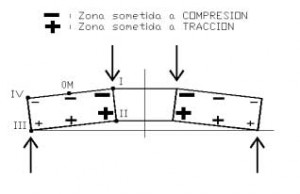Critical pressure points in elastic springs under load
When a disc spring is flexed, the upper layers of the disc are under pressure at compressor tensions, while the lower layers are under attraction tensions.
After a lot of deflections, this attraction tensions can produce breakage.
When the deflections number is lower than 5000 it can be considered an elastic application.
Before failure, the number of cycles of a spring is determined by the magnitude of tension transitions. When it passes from the minor deflection to the major deflection, this occurs in a determinate part of the lower surface.
Depending on the disc spring dimensions, these tension transitions will be higher in point II or III, and so the critical point will be II or III.
Approximately, it can be said that the critic point for a thick disc will be the point II and for a thin disc will be the point III.

The disadvantages of the tensile stress can be effectively counteracted by the spring preload in its use. The minimum preload would have to be approximately of 15% or 20% of total deflection, depending on the general tensions level in the disc spring.
In the section on elastic springs, we can find relevant information about its use and its assembly, to minimize these tensions and to extend the life of our stack:
Our calculation program and our specialists can help you in the implementation and the stack design of elastic springs. If you have some doubt about this please consult:
¿What do you think about it?

¿Qué opinas sobre este tema?